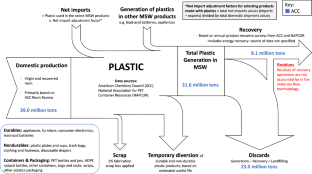A quantitative analysis of the US materials flow methodology and comparison to the EU methodology for MSW statistics
Abstract
The European Union (EU) and the United States (US) determine municipal solid waste (MSW) statistics differently. The EU applies a site-specific methodology that directly measures waste whereas the US employs a materials flow methodology that estimates MSW statistics indirectly based on production and recovery data from industries. This study dissects the materials flow methodology and presents quantitative materials flow Sankey diagrams for the primary MSW materials to highlight data gaps that can be addressed to improve the methodology’s accuracy. Private industry plastics data were applied to the materials flow methodology, and the results were within 10% of the plastics statistics reported by the US Environmental Protection Agency (US EPA). Drawbacks to the methodologies include EU measurement inaccuracies due to double-counting and not accounting for residual waste in the US. The latter may partially explain why landfilling tonnages reported by the US EPA were approximately 60% less than the tonnages reported by the Waste to Energy Research and Technology Council (WTERT) in its national MSW survey that applied the EU methodology in the US. Unlike the EU, there is no US national policy that requires states to measure and report state-level waste data to the US EPA. Future improvements in US MSW statistics rely heavily on the implementation of national policies to homogenize the measurement and collection of waste data from states.


 求助内容:
求助内容: 应助结果提醒方式:
应助结果提醒方式:


